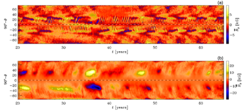The Sun’s hidden magnetic field during grand minimum
A study of the Sun’s long-term variation over a millennium by means of super computer modelling showed that during the Sun's grand minimum, the magnetic field may hide deep underneath the surface.
The Sun has an 11-year cycle that involves, among other things, the occurrence and disappearance of sunspots as well as strong changes in the global magnetic field of the Sun. A study conducted by the ReSoLVE Centre of Excellence at Aalto University in Finland with participation of the Max Planck Institute for Solar System Research (MPS) in Göttingen now investigated the mechanisms underlying these long-term variations in solar activity. The research team lead by Maarit Käpylä ran a global computer model of the Sun on Finland’s most powerful super computer over a period of six months. Their results surprisingly show that the Sun's magnetic field during a grand minimum is in fact at maximum. At the same time, they created the world’s longest numerical simulation that produces a solar-like dynamo solution complete with its long-term variation.
The most striking result of the study which was published in the May issue of the journal "Astronomy & Astrophysics" relates to the Sun’s silent periods known as grand minima, of which the Maunder Minimum is perhaps the best known. During this minimum which occurred between the years 1650 and 1700 astronomers could barely detect any sunspots despite their dedicated observing efforts. At the same time, the climate changed, and the Little Ice Age is known to have occurred in Europe, North America and China. The solar magnetic field was thought to wither during such grand minima and be so weak as not being capable of generating sunspots or other activity. The study now shows that in fact, the magnetic field was at its maximum during the Maunder Minimum.
‘The phenomena that occur in the Sun – including the cycle – change with time, so the behavior need to be investigated over a long time span. Short-term variation is not interesting for the purposes of studying the space climate, for example,’ says Maarit Käpylä, who is the head of the DYNAMO team in the ReSoLVE (Research on SOlar Long-term Variability and Effects) Centre of Excellence and also conducts astroinformatics or computational astrophysics and data-analysis at the Department of Computer Science at Aalto University.

For their study the researchers used computer codes to simulate the processes taking place in our Sun. With their computation they created the world’s longest numerical simulation that produces a solar-like dynamo solution complete with its long-term variation. 'The increasing computer power enables us to model the Sun and its magnetic evolution in great detail. We hope that in a few years our models can answer the long standing question why we have an 11-years cycle.' says co-author Jörn Warnecke who is a Marie-Curie fellow at the MPS. Unlike observations the simulations allow to study not only the surface but provide a three-dimensional representation of the magnetically active part of the Sun.
'Thus far, we have only been able to examine what is visible on the solar surface, but simulations enable us to see below the surface. During the Maunder Minimum, the magnetic field sinks to the bottom of the convection zone and is very strong there,’ says Käpylä.
The outer layer of the Sun, the convection zone, is like a boiling kettle with its moving and heat-transferring bubbles. This not only generates a magnetic field, but also makes the entire area turbulent and extremely challenging to model. ‘The Sun as such is impossible to replicate on present-day computers – or those of the near future – due to its strong turbulence. And indeed we are not claiming that this modelling would really be the Sun. Instead, it is a 3D construction of various solar phenomena by means of which the star that runs our space climate can be better understood,’ Käpylä explains.
Maarit Käpylä will start as an independent group leader at the MPS in June 2016. From September onwards her newly formed group will conduct research on solar and stellar magnetic activity. This involves 3D numerical simulation using high performance computing modeling the Sun and other stars as well as the observation of solar-like stars to determine the properties of their magnetic cylces. The operations of the Aalto DYNAMO team will continue under Käpylä’s direction, and both the German and the Finnish teams will focus on even larger simulations using graphical processing units.
